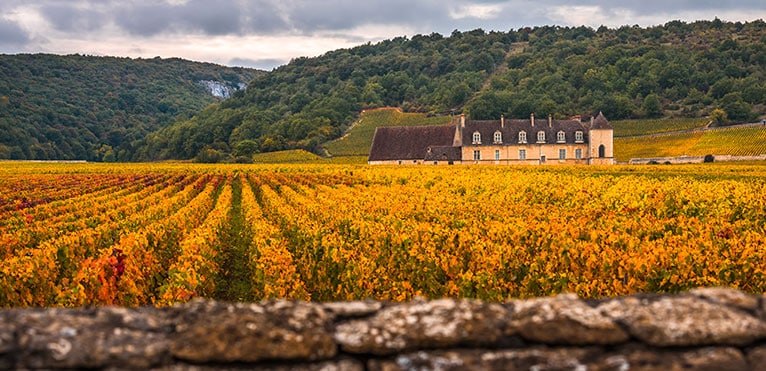
Contents
Bourgogne Aligoté is, as its name suggests, a regional appellation of Burgundy. Along with Bordeaux and Champagne, Burgundy is undoubtedly the most prestigious vineyard in France, thanks to its appellations that are the stuff of dreams the world over: Corton-Charlemagne, Volnay, Puligny-Montrachet, Nuits Saint Georges, Meursault… But Burgundy Aligoté is a much more affordable wine! It’s a chic, fresh wine whose appellation is coming back into fashion thanks to the hard work of the winemakers. Bourgogne Aligoté is a regional appellation, so it can be produced anywhere in the Burgundy vineyards. It’s a single-varietal wine made from Aligoté grapes, and therefore an exclusively white wine appellation.
Bourgogne-Aligoté, the origin of the famous kir
In Burgundy, the aligoté grape variety first appeared in the 17th century. Although very different from Chardonnay, Burgundy’s king grape variety, they share common origins. The appellation d’Origine contrôlée as we know it today dates back to 1937. The AOC Bourgogne Aligoté was created at the same time as the AOC Bourgogne to distinguish wines made from Chardonnay from those made from Aligoté. For the record, only one village appellation is made from the Aligoté grape: AOC Bouzeron. With the exception of Bouzeron, all Burgundy Aligotés come under theBourgogne Aligoté appellation.
Paradoxically, it was the kir, a beverage made from fruit cream and white wine, that helped put the Bourgogne Aligoté appellation on the map in the 20th century. Indeed, Chanoine Kir, deputy mayor of Dijon, enjoyed mixing his Bourgogne Aligoté with crème de cassis. The drink was so successful that in 1952, the Dijon company Lejay-Lagoute asked Chanoine Kir for a patent for his drink, as well as the right to use his name to name it! Over time, the kir was made with wines other than Bourgogne Aligoté, and the latter, after becoming more popular, was able to increase in quality and become the trendy appellation it is today.
Burgundy-Aligoté is an appellation with multiple terroirs
Bourgogne Aligoté can come from any commune in wine-growing Burgundy, from the Mâconnais to the Chablisien, the terroirs are very varied. However, the 1,575 hectares planted with Aligoté in Burgundy have similar characteristics. The soil remains predominantly clay-limestone with possible bands of marl, a soil where the Aligoté grape variety flourishes best. Burgundy enjoys a cool oceanic climate with continental or southern influences that sweep through the vines at altitudes generally between two and four hundred meters.
Bourgogne-Aligoté is a wine full of pep
As explained, wines from the Bourgogne Aligoté appellation can come from different terroirs, offering us a beautiful palette of varied aromas. However, thanks to their Aligoté grape variety, these wines still have a very lively, punchy profile. The profile of a typical Bourgogne Aligoté is a straw-gold color, limpid and brilliant. This wine is very floral on the nose, with notes of hawthorn and acacia, but also slightly fruity with aromas of peach, apple and pear. On the palate, Bourgogne Aligoté is a very fresh and pleasant wine. It shows a beautiful acidity sublimated by a very greedy side. One sip leads to another! To be enjoyed within 3 years to avoid losing the fruitiness of the wine. Optimum operating temperature is 10°C.
Bourgogne-Aligoté, a delight with poultry
Wines from the Bourgogne Aligoté appellation go perfectly with typical Burgundy dishes such as grilled andouillette, snails à la bourguignonne or a delicious jambon persillé. They can also be enjoyed with elaborate dishes such as four-vegetable risotto or grilled trout with almonds. In general, Bourgogne Aligoté is perfect as an aperitif, with fish, seafood, poultry and most cheeses.
2018, a very good year for Bourgogne-Aligotées
2010 and 2014 are exceptional vintages. But the years from 2015 to 2018 are rated as Great Vintages, so buying a Bourgogne Aligoté today means taking no chances, whatever the year!
Talented winemakers in Burgundy-Aligoté
Domaine Michel Lamblin Et Fils
Domaine Michel Lamblin et fils is headquartered in Chablis, but over the years and through successive generations, the Lamblin family has conquered the whole of Burgundy, from north to south, from Chablis to Mâconnais. And, of course, a visit to the vineyards of the Grand Auxerrois, where they produce the famous Bourgogne Aligoté, to the delight of our taste buds! Domaine Michel Lamblin & Fils’ Bourgogne Aligoté is remarkably lively, yet light and fresh. Slightly smoky, its aromas have notes of fresh grapes, green apple and lemon. The estate uses sustainable agriculture.
Domaine Jf & Pl Bersan
Domaine Jean François et Pierre Louis Bersan is heir to a great family of Burgundy Aligoté winemakers. In fact, the family has been in Saint Bris since 1453, with an estate that today covers 20 hectares, including 13 hectares of whites and 7 hectares of reds. The family is very proud of its exceptional terroir, for which it has great respect. The balance between tradition and modernity is the spearhead of the family. The winemakers compare their Bourgogne aligoté to a spring breeze. Made from old Aligoté vines (between 30 and 60 years old), Domaine JF & PL Bersan’s Bourgogne Aligoté expresses mineral and fruity notes, in particular pear and grapefruit.